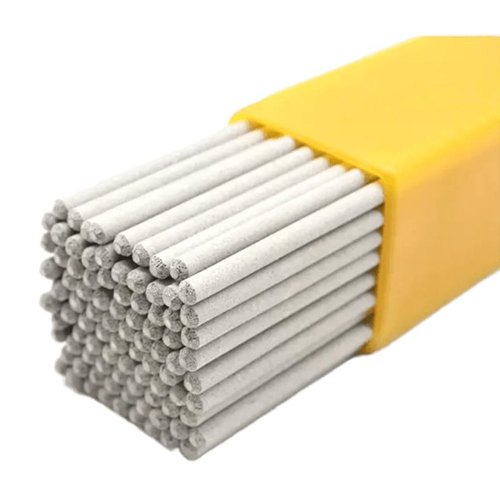CHARACTERISTICS & APPLICATIONS
íshín-2594S deposits weld metal containing 25.5 Cr, 10 Ni, 4 Mo, and 0.25 N. The sum of the Cr + 3.3 (Mo + 0.5 W) + 16 N, known as the Pitting Resistance Equivalent Number (PREN), is at least 40, thereby allowing the weld metal to be called a “super-duplex stainless steel.” This number is a semi-quantitative indicator of resistance to pitting in aqueous chloride-containing environments. It is designed for the welding of Type 2507 super duplex stainless steels UNS S32750 (wrought) and UNS J93404 (cast), and similar compositions. It can also be used for the welding of carbon and low-alloy steels to duplex stainless steels as well as to weld “standard” duplex stainless steels such as Type 2205 although the weld metal impact toughness may be inferior to that from E2209 electrodes. If post weld annealing is required, this weld metal will require a higher annealing temperature than that required by the duplex base metal.
These electrodes are designed for flat and horizontal fillet welding. In practice, most of these electrodes give higher deposition rates than their all-positional counterparts owing to their thicker coatings that contain higher levels of metal powders. The thicker coating gives larger fillet welds that are typically flat to concave. It also reduces the effects of core wire overheating, making 450 mm long electrodes possible for the larger electrodes, even with stainless steel core wire. Higher currents are usually required to achieve the necessary penetration compared to the all-positional types. The slag system of these electrodes is like those of the – 16 and -17 designations. The resulting slag may be more fluid and even slower freezing than that from -17 electrodes. The -26 electrodes are recommended for welding only in flat and horizontal fillet positions. Out of position welding may be possible with electrode sizes up to 3.2 mm diameter.
Storage and Drying Conditions: Hydrogen can have adverse effects on welds in some steels under certain conditions. One source of this hydrogen is moisture in the electrode coverings. For this reason, the proper storage, treatment, and handling of electrodes are necessary.
Holding Ovens: 125°C–150°C.
Drying Conditions: 250°C–425°C for 1 hour prior to use.
CHEMICAL COMPOSITION OF UNDILUTED WELD
| C | Cr | Ni | Mo | Nb+Ta | Mn | Si | P | S | N | Cu | Others |
| 0.04 | 24.0-27.0 | 8.50-10.50 | 3.50-4.50 | NS | 0.50-2.00 | 1.00 | 0.04 | 0.03 | 0.20-0.03 | 0.75 | NS |
Single values are maxima, except where specified otherwise.
ALL-WELD-METAL MECHANICAL PROPERTIES
| Tensile Strength, MPa | Yield Strength, At 0.2% Offset, MPa | Elongation % | Lateral Expansion, mm | Charpy V-Notch Impact at NS°C, Joules |
| 760 | NS | 15 | NS | NS |
Single values are minimal.
ELECTRODE SIZE & WELDING CURRENT (AC and DCEP)
| DIAMETER, mm | LENGTH, mm | Amperes |
| 2.50 | 350 | 65-90 |
| 3.15, 3.20 | 350 | 90-120 |
| 4.00 | 350 | 120-150 |
| 5.00 | 350 | 160-200 |
WARNING: Safety and health information is available from many sources, including, but not limited to Safety and Health Fact Sheets listed in A11.3, ANSI Z49.1 Safety in Welding, Cutting, and Allied Processes published by the American Welding Society, 8669 Doral Blvd., Suite 130, Doral, FL 33166., and applicable federal and state regulations. The Safety and Health Fact Sheets are revised, and additional sheets added periodically.

